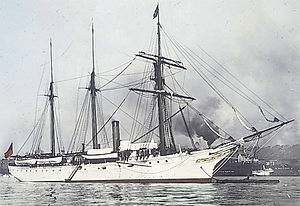USC&GS Carlile P. Patterson

USC&GS Carlile P. Patterson
|
|
| History | |
|---|---|
|
|
|
| Name: | USC&GS Carlile P. Patterson |
| Namesake: | Carlile P. Patterson (1816–1881), Superintendent of the United States Coast and Geodetic Survey |
| Owner: |
|
| Ordered: | 1883 |
| Builder: | James D. Leary, Brooklyn, New York |
| Cost: | $100,000 |
| Launched: | January 15, 1884 |
| Sponsored by: | Miss Katie Patterson, daughter of the late Capt. Carlile P. Patterson |
| Commissioned: | April 1, 1884 |
| Recommissioned: | 1918 (United States Navy) |
| Decommissioned: | 1919 |
| In service: | 1884–1919, 1924–1938 |
| Out of service: | 1919–1924 (?) |
| Renamed: |
Forward, August 15, 1918; Patterson 1924 or earlier |
| Fate: | Wrecked, 1938 |
| General characteristics | |
| Type: | Survey ship |
| Tonnage: | 604 |
| Displacement: | 719 |
| Length: | 163 ft (50 m) |
| Beam: | 27.4 ft (8.4 m) |
| Draft: | 14.2 ft (4.3 m) |
| Depth of hold: | 10.3 ft (3.1 m) |
| Decks: | 2 |
| Deck clearance: | 7 ft (2.1 m) upper deck |
| Installed power: | Cross compound vertical steam engine, cylinders 17 and 31 inches × 28 inch stroke, 215 ihp; replaced by 325 hp diesel 1924 |
| Propulsion: | 8-ft screw |
| Sail plan: | Barkentine |
| Speed: | 7–9 knots (steam) |
| Boats & landing craft carried: |
7 |
| Crew: | 12–13 Officers, 40–46 crewmen |
| Armament: | Gatling guns; 2 6-pounders during naval service |
Forward, August 15, 1918;
The USC&GS Carlile P. Patterson was a survey ship of the United States Coast and Geodetic Survey in operation between 1883 and 1918. Subsequently she had a brief period of naval service and fifteen seasons as a merchant vessel before she was wrecked on the Alaska coast in 1938.
The Patterson was named for Carlile Pollock Patterson, fourth Superintendent of the Coast Survey and first of the Coast and Geodetic Survey. The New York Times credited the design to Commander Colby Mitchell Chester, USN, at that time Hydrographic Inspector in USC&GS. Naval architect Samuel Hartt Pook, U.S. Naval Constructor, was credited with supervising the drawings. She was built of wood in James D. Leary's yard at Williamsburg (Brooklyn) New York. Frames were white oak with cedar tops; planking, beams and lower deck were yellow pine, the upper deck was white pine. Her hull was fitted with iron diagonal braces, and five watertight bulkheads (3 wood, 2 iron). Power was a Cross compound vertical steam engine (one source reports 356 hp, another source says 215 ihp; this difference may represent different calculation or measurement methods) and she could carry 133 tons of coal as fuel. Her machinery was constructed by Neafie & Levy of Philadelphia. She was rigged as a barkentine with double topsail yards; standing rigging was galvanized charcoal-iron wire. Her boats were two steam launches, two cutters, two whaleboats, and a dinghy. Her deckhouse, 13 × 62 ft, included the engine and boiler rooms, galley, pantry, and a drafting room. She carried a Sigsbee piano-wire sounding machine, state-of-the-art for deep-water hydrography, holding five miles of wire. Lieutenant Richardson Clover, USN, supervised construction and became her first commander.
...
Wikipedia
